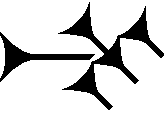mu (cuneiform) on:
[Wikipedia]
[Google]
[Amazon]
 The
The
Image:Amarna_letter-_Royal_Letter_from_Ashur-uballit,_the_king_of_Assyria,_to_the_king_of_Egypt_MET_DP-211-142.jpg, line drawing, Obverse
A common Amarna letter that uses cuneiform mu.
(line 19, ''Reverse''.) Image:Amarna_letter-_Royal_Letter_from_Ashur-uballit,_the_king_of_Assyria,_to_the_king_of_Egypt_MET_DP-211-143.jpg, line drawing, Reverse
Cuneiform signs
 The
The cuneiform
Cuneiform is a Logogram, logo-Syllabary, syllabic writing system that was used to write several languages of the Ancient Near East. The script was in active use from the early Bronze Age until the beginning of the Common Era. Cuneiform script ...
sign mu, is a common-use sign of the Amarna letters, the ''Epic of Gilgamesh
The ''Epic of Gilgamesh'' () is an epic poetry, epic from ancient Mesopotamia. The literary history of Gilgamesh begins with five Sumerian language, Sumerian poems about Gilgamesh (formerly read as Sumerian "Bilgames"), king of Uruk, some of ...
,'' and other cuneiform texts (for example Hittite texts). It is also used as MU in which case it is a Sumerogram
A Sumerogram is the use of a Sumerian cuneiform character or group of characters as an ideogram or logogram rather than a syllabogram in the graphic representation of a language other than Sumerian, such as Akkadian, Eblaite, or Hittite. Th ...
meaning "name," "year" or "life."
Linguistically, it has the alphabetical usage in texts for ''m'', or ''u'', or syllabically for ''mu''. The u is replaceable in word formation by any of the 4 vowels: ''a, e, i,'' or ''u''.
One reason for the high usage of mu in the Amarna letters is for the word: "peace", or "be safe", Akkadian language
Akkadian ( ; )John Huehnergard & Christopher Woods, "Akkadian and Eblaite", ''The Cambridge Encyclopedia of the World's Ancient Languages''. Ed. Roger D. Woodard (2004, Cambridge) Pages 218–280 was an East Semitic language that is attested ...
''šalāmu'', for ''"to be sound, whole, safe"''. It is used especially between the Great King letters.
''Epic of Gilgamesh'' usage
The ''mu'' sign usage in the ''Epic of Gilgamesh'' is as follows: ''mu''-(266 times); ''MU''-(87).References
* Moran, William L. 1987, 1992. ''The Amarna Letters.'' Johns Hopkins University Press, 1987, 1992. 393 pages.(softcover, ) * Parpola, 1971. ''The Standard BabylonianEpic of Gilgamesh
The ''Epic of Gilgamesh'' () is an epic poetry, epic from ancient Mesopotamia. The literary history of Gilgamesh begins with five Sumerian language, Sumerian poems about Gilgamesh (formerly read as Sumerian "Bilgames"), king of Uruk, some of ...
'', Parpola, Simo, Neo-Assyrian Text Corpus Project
The Neo-Assyrian Text Corpus Project is an international scholarly project aimed at collecting and publishing ancient Assyrian texts of the Neo-Assyrian Empire and studies based on them. Its headquarters are in Helsinki in Finland.
State Archives ...
, c 1997, Tablet I thru Tablet XII, Index of Names, Sign List, and Glossary-(pp. 119–145), 165 pages.
----
Amarna letter EA 15
Amarna (; ) is an extensive ancient Egyptian archaeological site containing the ruins of Akhetaten, the capital city during the late Eighteenth Dynasty of Egypt, Eighteenth Dynasty. The city was established in 1346 BC, built at the direction of ...
-(titled: ''"Assyria joins the International Scene"'').A common Amarna letter that uses cuneiform mu.
(line 19, ''Reverse''.) Image:Amarna_letter-_Royal_Letter_from_Ashur-uballit,_the_king_of_Assyria,_to_the_king_of_Egypt_MET_DP-211-143.jpg, line drawing, Reverse